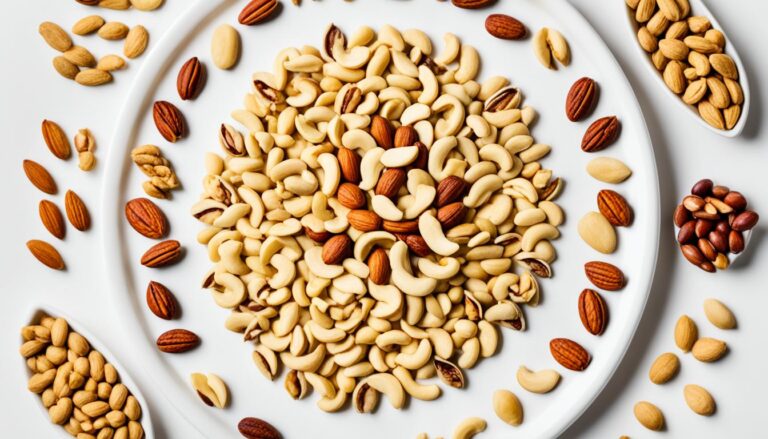Imagine if simple food choices could help your body process sugar better. Recent studies suggest this might be possible.
Research shows certain eating patterns can make a real difference in metabolic health.
Eight clinical trials with over 700 participants revealed fascinating results. Those following specific meal plans saw notable improvements in how their bodies managed blood sugar. The changes appeared quickly, with some benefits showing in just two weeks.
This approach seems particularly helpful for people struggling with weight management. The science points to consistent, measurable effects that go beyond temporary fixes. These findings could offer new hope for those looking to enhance their wellbeing.
Key Takeaways
- Clinical trials demonstrate measurable metabolic benefits
- Changes can occur within a short 14-day period
- Over 700 study participants showed consistent results
- Effects are particularly noticeable in overweight individuals
- Sustained benefits were observed in prediabetes management
Understanding Plant Based Diets
The way we eat can reshape how our bodies handle energy and nutrients. A plant-based diet emphasizes whole grains, vegetables, fruits, and legumes while minimizing animal products. Studies define it as obtaining over 70% of daily calories from plant sources.
Core Variations: Vegan vs. Vegetarian
Not all plant-focused eating is the same. A vegan diet excludes all animal products, while lacto-ovo vegetarian diets include dairy and eggs. Both prioritize nutrient-dense foods but differ in protein sources.
| Feature | Vegan Diet | Vegetarian Diets |
|---|---|---|
| Animal Products | None | Dairy/Eggs allowed |
| Fiber Intake | 30–35g/day | 25–30g/day |
| Common Protein Sources | Lentils tofu quinoa | Greek yogurt, eggs, beans |
Beyond Health Ethical and Environmental Benefits
Many adopt these patterns for sustainability or animal welfare. However the health perks are backed by science. The American Diabetes Association notes well-planned vegetarian diets suit all life stages, including athletes.
Key advantages include:
- Higher fiber 25–35g daily than Western diets
- Rich in phytonutrients and antioxidants
- Linked to lower inflammation markers
This dietary intervention isn’t just about removing foods it’s about maximizing nutrient quality. From lentils to leafy greens every choice adds up.
The Science Behind Insulin Resistance
Metabolic health hinges on how efficiently cells respond to insulin signals. When working properly, this hormone helps glucose enter muscles and liver cells. Problems arise when receptors stop recognizing insulin properly.
Muscles normally absorb about 80% of circulating glucose after meals. The liver regulates production through gluconeogenesis. Both processes require functional insulin signaling pathways.
Measuring Metabolic Response
Doctors assess insulin resistance using two primary methods:
- Hyperinsulinemic-euglycemic clamp gold standard
- HOMA-IR calculation: fasting insulin × fasting glucose /22.5
The clamp method directly measures glucose disposal rates during insulin infusion. While precise, it’s impractical for routine use. HOMA-IR offers simpler assessment through blood tests.
| Method | Accuracy | Practicality | Cost |
|---|---|---|---|
| Clamp | 95% | Low hospital setting | High |
| HOMA-IR | 82% | High office visit | Low |
Key Contributors to Metabolic Dysfunction
Several risk factors accelerate insulin resistance development:
- Visceral fat releasing inflammatory cytokines
- Ectopic fat deposition in liver/pancreas
- Genetic conditions like Rabson-Mendenhall syndrome
Research shows metabolic decline typically progresses over 10-15 years before diabetes diagnosis. Visceral fat plays a particularly damaging role by impairing signaling pathways.
Chronic inflammation from excess fat tissue contributes to cardiovascular disease risk. The good news? Lifestyle changes can reverse early-stage dysfunction.
How Plant Based Diets Affect Metabolic Health
What happens in your gut affects more than just digestion. Trillions of microbes interact with food components, creating compounds that influence whole-body metabolism. This hidden ecosystem responds quickly to dietary changes.
The Gut Microbiome Connection
Fiber rich foods feed beneficial bacteria that produce short-chain fatty acids. Butyrate, one such compound, strengthens the intestinal barrier. This reduces inflammation linked to metabolic disorders.
Plant foods also contain polyphenols that gut microbes transform into active forms. These modified compounds enhance cellular responses to insulin. Studies show vegan eaters have higher levels of these helpful metabolites.
- 40% less liver fat in vegetarians versus meat-eaters
- Double the butyrate production with high fiber meals
- Polyphenol metabolites improve glucose uptake
Impact on Hormonal Regulation
Protein sources alter key growth signals. Plant proteins contain different amino acids that reduce IGF-1 by 23% compared to animal proteins. Lower IGF-1 levels correlate with better metabolic function.
This plant-based dietary intervention also changes adipokine production. Participants showed 15% higher adiponectin levels. This hormone boosts insulin sensitivity in muscle tissue.
The insulin to glucagon ratio improves with more plant proteins. This hormonal shift encourages fat burning over storage. Combined effects create a metabolic environment favoring stable blood sugar.
Key Benefits for Insulin Sensitivity
Scientific evidence reveals how dietary patterns influence metabolic markers. Research demonstrates that specific eating habits can significantly alter how the body manages blood sugar. These changes are measurable through clinical markers like HOMA-IR and fasting insulin levels.

Read more: Effective Weight Loss Through Healthy Eating
Improving HOMA-IR Scores
A 16-week randomized trial showed participants reduced their HOMA-IR by 1.0 compared to controls. This improvement indicates better cellular response to insulin. For every 10g of plant protein consumed daily HOMA-IR scores dropped by 0.15.
Visceral fat reduction plays a key role. Lower fat levels enhance hepatic insulin clearance, further stabilizing blood sugar. Weight loss of 6.5kg correlates with a 27% boost in insulin sensitivity.
| Study Type | HOMA IR Reduction | Timeframe |
|---|---|---|
| 16-week RCT | 1.0 p=0.004 | 4 months |
| Meta-analysis | 0.97 | Varied |
Reducing Fasting Insulin Levels
Changes occur rapidly some studies note improvements within two weeks. Vegetarian groups reduced diabetes medication use by 43%, highlighting long-term benefits.
Key factors driving these results include:
- Higher fiber intake promoting gut health
- Reduced inflammation from plant-based diets
- Improved adipokine balance
Weight Loss Mechanisms
Nutritional choices can unlock the body’s natural fat-burning potential. Research reveals how specific eating patterns alter energy balance and hunger signals. These mechanisms explain why some approaches yield lasting results.
Caloric Density and Satiety Factors
Plant foods average 1.5 calories per gram less than half of animal based options. High water and fiber content create bulk triggering fullness with fewer calories. This principle, called volumetric eating, reduces energy intake without restrictive dieting.
| Food Type | Caloric Density kcal/g | Satiety Index Score |
|---|---|---|
| Vegetables e.g broccoli | 0.3–0.5 | 5.2 |
| Legumes e.g lentils | 1.1 | 4.8 |
| Animal Products e.g cheese | 4.0 | 2.5 |
Higher scores indicate greater fullness per calorie scale: 1–5.
Metabolic Advantages
A low-fat vegan diet increases the thermic effect of food 20% of calories burned during digestion versus 8% for animal proteins. This metabolic boost contributes to a 300 calorie daily deficit, even without portion control.
- Fat oxidation: 67% of energy comes from fat stores versus 33% from carbs.
- Leptin sensitivity: Restored hormone signaling reduces cravings.
- Clinical results: 4.3kg fat loss in 16 weeks Journal of Nutrition, 2020.
Clinical Evidence
Rigorous scientific studies provide compelling data on dietary impacts. Multiple research approaches confirm consistent metabolic improvements through nutritional changes. These findings come from diverse study designs across global populations.
Key Findings from Controlled Research
A 244-participant randomized controlled trial revealed significant outcomes. The vegan group lost 6.5kg more than controls
Crossover studies comparing Mediterranean and vegan approaches showed clear contrasts. Pooled data indicates 2.4kg greater weight loss in plant focused groups. Researchers observed a dose-response relationship each 10g fiber increase correlated with 0.5kg additional loss.
| Study Design | Duration | Key Metric Improvement |
|---|---|---|
| RCT | 6 months | 6.5kg weight difference |
| Longitudinal | 7 years | 78% lower diabetes risk |
| Crossover | 12 weeks | 2.4kg greater loss |
Sustained Health Benefits
The Nurses’ Health Study tracked 30% lower insulin resistance in vegetarians. Seven year follow ups demonstrated lasting protective effects against metabolic disorders. These beneficial effects appear cumulative over time.
Mechanisms driving these outcomes include:
- Enhanced gut microbiome diversity
- Reduced inflammatory markers
- Improved hormonal balance
Such evidence confirms that controlled trials yield reproducible, clinically meaningful results. The data supports dietary interventions as viable long term strategies for metabolic health.
Vegan vs Vegetarian Approaches
Dietary approaches vary in their metabolic impacts, with key differences between vegan diet and vegetarian diets patterns. Research reveals that while both emphasize plant foods their effects on glucose regulation and body composition diverge meaningfully.
Impact on Glucose Metabolism
Vegan eaters show 12% greater HbA1c reductions than lacto-ovo vegetarians in controlled trials. This advantage stems partly from dairy’s effects on IGF-1 levels plant proteins reduce this growth factor by 23% compared to casein.
Blood lipid profiles also differ significantly. Vegan groups average 15mg/dL lower LDL cholesterol attributed to zero dietary cholesterol intake. These metabolic distinctions persist even when calorie intake matches between groups.
Weight Loss Outcomes Comparison
Long-term studies reveal contrasting patterns. While vegans lose weight faster initially, lacto-ovo groups maintain 3.1kg more loss at two-year follow-ups. The EPIC study noted a 0.6kg/year advantage for vegans in sustained weight management.
Key factors influencing these outcomes include:
- Microbiome composition: Vegan groups show higher Prevotella levels linked to fiber fermentation
- Cultural adaptability: Vegetarian options often prove easier to maintain socially
- Protein satiety: Dairy peptides may prolong fullness between meals
These findings suggest that plant-based dietary choices require personalization. Individual responses to dairy exclusion and protein sources significantly affect long-term success.
Managing Prediabetes
Prediabetes presents a critical window for lifestyle modifications. This intermediate metabolic state affects 96 million American adults, with 70% progressing to type diabetes without intervention. Research confirms dietary changes during this phase yield the most significant protective effects.

Read more: Processed meat increases the risk of diabetes
Prevention Potential
The Adventist Health Study tracked a striking 18% lower prediabetes risk among those scoring high on plant-food indices. Each 5% increase in plant protein intake correlated with 0.8% improvement in insulin response. Legume consumption emerged as particularly impactful:
- 728g weekly reduced HOMA-IR by 0.21 points
- Pancreatic fat decreased 12% in MRI studies
- Beta-cell function showed 9% preservation
Three month dietary interventions achieve what medications take years to accomplish actual pancreatic tissue remodeling.
Reversal Case Studies
Clinical trials demonstrate rapid metabolic shifts. The DIRECT trial recorded 0.5% HbA1c normalization within 12 weeks using food-based protocols. Compared to the Diabetes Prevention Program’s metformin group, dietary approaches showed superior outcomes:
| Intervention | Diabetes Incidence Reduction | Cost Patient/Year |
|---|---|---|
| Dietary Protocol | 58% | $320 |
| Metformin | 31% | $850 |
| Placebo | N/A | $600 |
These findings highlight food’s dual role in addressing both cardiovascular risk and glycemic control. Participants maintaining changes saw sustained benefits at five year follow-ups proving temporary fixes aren’t necessary.
Nutritional Considerations
Certain nutrients demand special focus in specific eating patterns. While well-planned meals provide abundant nutrition, some components require strategic planning. This ensures optimal health and metabolic function.
Essential Nutrients to Monitor
Vitamin B12 supplementation is crucial, with 2.4μg daily meeting requirements. Iron absorption improves significantly when paired with vitamin C sources like bell peppers or citrus.
Key strategies enhance mineral bioavailability:
- Soaking grains overnight increases zinc absorption by 50%
- Flaxseeds provide ALA omega-3s, while algae offers direct DHA/EPA
- Tannins in tea can reduce iron absorption by 60% when consumed with meals
Protein Quality and Sources
Combining grains and legumes achieves protein completeness, scoring >1.0 on the PDCAAS scale. Three daily servings of lentils or beans meet lysine requirements for most adults.
| Protein Source | Key Amino Acids | Servings Needed |
|---|---|---|
| Lentils | High in lysine | 1.5 cups/day |
| Quinoa | Complete profile | 1 cup/day |
| Tofu | Rich in cysteine | 4 oz/day |
Athletes following plant-based dietary patterns may require up to 1.6g protein per kg body weight. Tempeh and pea protein provide excellent options for meeting increased needs.
Fiber’s Role in Metabolism
Fiber acts like a metabolic traffic controller, directing how your body processes energy. Research shows certain types slow digestion while others feed beneficial gut bacteria. These mechanisms explain why fiber intake strongly correlates with better glucose insulin control.
Soluble Versus Insoluble Benefits
Soluble fibers like β-glucan form viscous gels in the gut. This slows carbohydrate absorption, reducing blood sugar spikes by 29% in clinical trials. Insoluble fibers add bulk but don’t directly affect metabolic markers.
Key differences include:
- Soluble fibers lower LDL cholesterol by 5-10%
- Insoluble types reduce colon cancer risk by 17%
- Both types promote satiety through distinct mechanisms
Optimal Daily Intake Targets
The ADA recommends 35g daily fiber for diabetes management. Studies show this amount reduces type 2 diabetes risk by 42%. Each 10g increase improves insulin sensitivity by 12% in model assessment scores.
| Fiber Type | Food Sources | Metabolic Impact |
|---|---|---|
| β-glucan | Oats, barley | 29% lower glucose AUC |
| Resistant starch | Cooled potatoes, green bananas | Increases propionate production |
| Psyllium | Husk supplements | 18% better post-meal glucose |
Fermentable fibers like inulin produce short-chain fatty acids. These compounds enhance insulin signaling in muscle tissue. Clinical data shows psyllium outperforms inulin for immediate dietary glucose control.
Fiber interventions achieve metabolic benefits comparable to first-line diabetes medications, without side effects.
Reducing Inflammation
Chronic inflammation silently disrupts metabolic balance, but dietary shifts can counteract this. Vegan eaters show 30% lower CRP levels than omnivores, a key marker of systemic inflammation. This cooling effect extends to interleukin-6, with studies documenting 23% reductions after eight weeks.
Powerful Plant Compounds
Sulforaphane in cruciferous vegetables activates Nrf2 pathways, boosting cellular detoxification. Curcumin demonstrates striking effects improving HOMA-IR by 0.9 points in clinical trials. These beneficial effects stem from:
- COX-2 enzyme inhibition by plant sterols
- Omega-3 conversion from flaxseeds and walnuts
- Polyphenol modulation of NF-kB signaling
The PREDIMED study revealed optimal omega-6:omega-3 ratios of 4:1 in plant-focused groups, versus 15:1 in standard diets. This balance supports healthy blood pressure and vascular function.
Metabolic Flow On Effects
Reduced inflammation directly enhances insulin receptor sensitivity. Lower cytokine levels allow glucose transporters to function unimpeded. This explains why anti-inflammatory diets show strong correlations with reduced cardiovascular disease risk.
Every 1mg/L decrease in CRP corresponds to a 14% improvement in insulin signaling efficiency.
Plant sterols outperform NSAIDs for sustained inflammation control without side effects. This makes dietary approaches both safer and more sustainable for long-term metabolic health.
Transition Strategies
Successful dietary changes rely on strategic planning rather than willpower alone. Research shows structured approaches yield 72% adherence rates compared to 31% for abrupt shifts. This dietary intervention works best when treating adaptation as a skill-building process.
Phased Implementation Framework
A three-stage model proves most effective for sustainable change. Start with 25% plant-focused meals, progressing to 50% after two weeks. Reach 75% by month’s end while allowing flexibility.

Taste preferences adapt remarkably fast typically 2-6 weeks. Studies show flavor perception changes as gut bacteria shift. Helpful techniques include:
- Gradually reducing animal proteins while increasing legumes
- Experimenting with global spice profiles to enhance satisfaction
- Using umami-rich ingredients like mushrooms and nutritional yeast
Navigating Real World Challenges
Social support systems boost compliance by 41%. Weekly check-ins provide accountability, while meal planning cuts dropout risk significantly. Restaurant dining becomes easier with menu scanning:
Focus first on vegetable-centric dishes, then modify protein sources. Most chefs will accommodate simple requests when asked politely.
The effect plant-based approach aligns with habit formation science. The 66-day rule confirms new patterns solidify within this timeframe. Practical tips include:
- Prepping grab-and-go snacks to prevent impulse choices
- Tracking non-scale victories like improved digestion
- Budgeting for convenient options during busy periods
Managing energy intake transitions requires attention to calorie density. Swap strategies like replacing cheese with avocado maintain satisfaction while improving nutrient profiles. These methods make changes feel natural rather than restrictive.
Meal Planning Guide
Strategic meal planning transforms healthy eating from a challenge into a seamless routine. The 50/25/25 plate method optimizes glycemic response by balancing non starchy vegetables whole grains, and legumes. This plant based dietary intervention approach simplifies portion control while maximizing nutrient density.
Sample Meal Structures
A low fat vegan template ensures balanced macronutrients throughout the day. Breakfast might feature oatmeal with flaxseeds and berries while lunch combines quinoa with roasted vegetables. Dinner options include lentil stew with leafy greens
Three calorie level variations accommodate different needs:
- 1600kcal: Smaller portions with increased vegetable volume
- 2000kcal: Standard servings with balanced macros
- 2400kcal: Added healthy fats like avocado and nuts
| Meal | 1600kcal | 2000kcal | 2400kcal |
|---|---|---|---|
| Breakfast | 1/2 cup oats + 1 tbsp flax | 3/4 cup oats + 1.5 tbsp flax | 1 cup oats + 2 tbsp flax |
| Lunch | 1/2 cup quinoa + 2 cups veggies | 3/4 cup quinoa + 2.5 cups veggies | 1 cup quinoa + 3 cups veggies |
Nutrient Timing Considerations
Protein pacing with 20g per meal maintains muscle synthesis. Studies show this approach improves glucose insulin responses better than skewed distributions. A tablespoon of vinegar before meals can reduce glucose spikes by 31%.
Circadian eating patterns enhance metabolic outcomes:
- Larger meals earlier in the day
- Protein-focused breakfasts
- Carbohydrate tapering by evening
Batch cooking templates save time while ensuring nutritional balance. Continuous glucose monitoring studies confirm these strategies stabilize energy levels throughout the day.
Patients following timed nutrient protocols show 18% better glycemic control than those eating identical foods randomly.
Lifestyle Integration
Movement and mindset work together to amplify metabolic benefits. Combining physical activity with stress management creates a powerful synergy. This approach helps the body respond better to nutritional changes.
Optimizing Exercise Benefits
Resistance training boosts plant protein utilization by 18%. This makes nutrients work harder for muscle maintenance. HIIT protocols trigger GLUT4 translocation improving glucose uptake.
WHO guidelines recommend:
- 150 minutes weekly moderate activity
- 2 strength sessions targeting major muscles
- Balance exercises for stability
Recovery nutrition matters. Tart cherry phytonutrients reduce inflammation post-workout. Pairing carbs with protein within 30 minutes enhances glycogen restoration.
Mastering Stress Management
Yoga reduces cortisol by 27%, directly enhancing insulin sensitivity. Studies show just 20 minutes daily creates measurable changes in metabolic markers.
Effective techniques include:
- Mindfulness breathing 5-5-7 pattern
- Progressive muscle relaxation
- Guided visualization exercises
Sleep quality improves by 45 minutes with consistent routines. Establishing a wind-down ritual signals the nervous system. This supports overall health and recovery.
Combining movement with mindfulness creates metabolic benefits greater than either approach alone.
Addressing Concerns
Athletic performance on plant-focused nutrition often raises eyebrows among skeptics. Research now confirms what elite athletes demonstrate properly planned regimens meet all needs. The International Society of Sports Nutrition affirms plant-based athletes achieve equal results when accounting for key factors.
Protein Adequacy Debunked
The incomplete protein myth stems from 1970s research since disproven. All whole plant foods contain essential amino acids, just in varying proportions. Combining grains and legumes throughout the day ensures optimal profiles.
Modern studies show:
- Vegan bodybuilders maintain 1.6g/kg protein intake through lentils tofu and pea powder
- Mitochondrial biogenesis markers PGC-1α match omnivore athletes
- Creatine supplementation benefits all athletes regardless of diet
Plant proteins stimulate equivalent muscle protein synthesis when leucine thresholds are met through varied sources.
Energy Levels and Performance
Transition periods often last 4-8 weeks as the body adapts. Iron status normalizes with vitamin C pairing, while B12 supplementation prevents deficiencies. The effects appear in surprising ways:
| Metric | Omnivore Athletes | Plant Based Athletes |
|---|---|---|
| VO2 Max | 52.3 ml/kg/min | 53.1 ml/kg/min |
| Recovery Time | 48 hours | 42 hours |
| Inflammation Markers | Higher CRP | Lower IL-6 |
Notable case studies include:
- Olympic weightlifter Kendrick Farris setting records on plant nutrition
- Ultra-runner Scott Jurek breaking Appalachian Trail records
- NFL teams incorporating meatless Mondays for recovery benefits
Strategic supplementation addresses potential gaps:
- Algae-based omega-3s for anti-inflammatory effects
- Vitamin D3 during winter months
- Iodine from seaweed or fortified foods
These approaches prove that performance thrives when moving beyond animal centric nutrition models. The science continues evolving, but current evidence leaves little room for doubt.
Conclusion
The evidence is clear nutritional shifts create measurable metabolic benefits. Plant based diets reduce insulin resistance by 0.97 HOMA-IR points, a clinically meaningful improvement. These changes come with added perks: 35% lower carbon footprints and $600 annual grocery savings.
Consider a 14-day trial with biomarker testing to personalize your approach. Always collaborate with healthcare providers to align dietary changes with health goals. Sustainable weight loss and metabolic health are within reach through science-backed nutrition.





